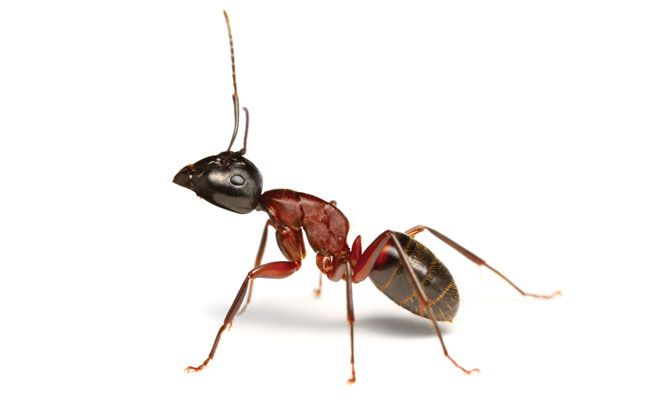
Photo: Antagain/iStock / Getty Images Plus/Getty Images
Pest Management Professional magazine (PMP): Well, it is that time again. We have warm weather, and insects are moving. This is a perfect time to talk about ants. Featured this month is the carpenter ant. Hi, Carpie, welcome to PMP.
Carpenter ant (CA): Thinnx. Moufull. Sorry! Had a mouthful of a favorite food: honeydew. Not the melon, the insect secretions. Mmm!
PMP: Tell us a bit about carpenter ants and your range.
CA: Well, we can be found in most of the United States and parts of Canada. There are multiple species of carpenter ants, but our habits are similar.
PMP: It is a misconception among customers that you eat wood. That isn’t true, but why do you think people believe that?
CA: We prefer to start with wood that might have some decay and moisture damage. It is softer to begin hollowing out for our abode. We are quite happy to then move to sound wood. It does look like we are consuming the wood, but your sleuth inspectors know better. We’re just building our nest.
PMP: How is that?
CA: We are fussy about keeping things neat and clean. You will not see jagged edges, and you won’t see a lot of mud. We leave the mud-slinging to those nasty termites.
PMP: Sometimes we see piles of sawdust that was kicked out by carpenter ants. Would you explain that?
CA: As we hollow out wood, we kick out the wood debris. We also kick out insect parts from our food, or even dead carpenter ants. If you see small chunks of wood resembling sawdust, it might mean we are nearby.

Greg Baumann
PMP: What is the difference between the frass you kick out and sawdust from, say, remodeling?
CA: We leave what appears to be sawdust, but on a closer look you will see the wood is a bit rougher than sawdust. It will have dirt and insect parts, most likely. That is why it is always good to carry a hand lens.
PMP: And the sawdust from a saw has no insect parts or other discarded waste from the gallery, and we can then call it…?
CA: That’s right, carpenter damage. Not carpenter ant damage. (Guffaws.)
PMP: Most species can have satellite nests, or colonies that have spun off from the main colony. How many ants are in a typical colony?
CA: Well, for example, most common carpenter ants will have a colony of a few thousand, but if you add up all the satellite nests associated, it can be five to 10 times that.
PMP: Let’s talk about control. I know it is a sore subject because I am sure you don’t like to think about the loss of your fellow ants. If you please, though, can you tell us about control?
CA: Look, we really prefer to be in the woods; but we do wander into homes, so I have no problem talking about control near structures. Just don’t try to eradicate us from forests.
PMP: Deal. What is the biggest control mistake people make, especially the customer?
CA: That’s easy. They see an ant on the deck or on siding, and they immediately wipe out the foragers. Sure, it controls a few ants, but they have just destroyed the lead that will get them right to the colony. Observe and know the biology.
PMP: That is a great observation and a great story for technicians. Ask the customer where they’ve seen carpenter ants and whether they have tried to control the ants using their own products. Go there and start the search for the colony.
CA: That’s right. (Looks around.) Well, I see some firewood that my buddies are starting to tear into. We’ll sure surprise this homeowner next winter.
PMP: Thanks for your time.
CA: Sure. (Scampers toward the wood pile.) Hey guys! Save me some soft wood!
The post Carpenter ant shares ID, control tips appeared first on Pest Management Professional.
from Pest Management Professional https://www.mypmp.net/2022/05/17/carpenter-ant-shares-id-control-tips/
Sacramento CA
No comments:
Post a Comment